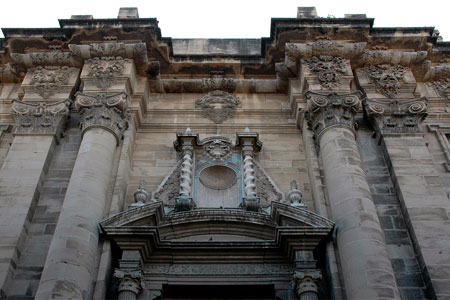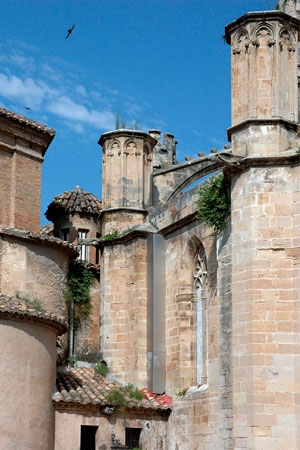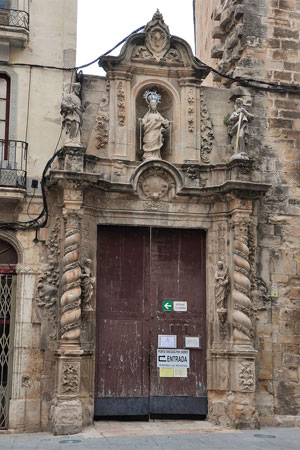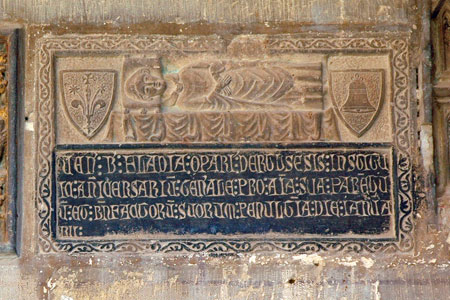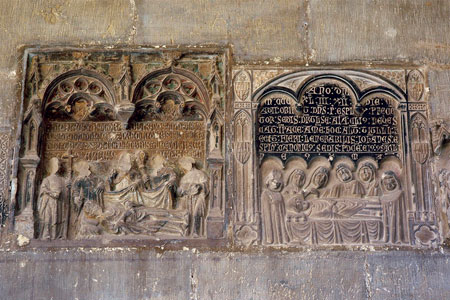The bishopric of Tortosa has very ancient origins, the first documented bishop being Urso, who attended the Council of Tarragona in 516. With the Saracen invasion it practically disappeared and after the conquest of the city by the army under the command of the Count of Barcelona, Ramon Berenguer IV (1148), it had to be restored.

Façade of the cathedral after the demolition (2015)
of the buildings that separated it from the Ebro
In 1151, the new bishop, Gaufred (or Jofre, 1151-1165), was consecrated in an act that also saw the establishment of an Augustinian canonry according to the directives of Saint-Ruf of Avignon; in fact, the bishop was the abbot of the canonry of Saint-Ruf (Avignon, Vaucluse), and the canons who formed the first community also came from there. In 1153 the community was formally constituted, and in the same act both the canonry and the bishopric, two deeply linked institutions, were endowed with the goods from the conquest: the mosques of the city passed into their hands and the territory of the diocese would be that of the taifa of Tortosa.
Initially, the mosque itself and the adjoining buildings were used for the canonical community, but in 1156 Pope Adrian IV intervened on behalf of the bishop and the canons and influenced Count Ramon Berenguer IV to intervene in the construction of the new cathedral, which began to be built in 1158 on what had been the main mosque, and which was consecrated in 1178. During this period, the seat of Tortosa received important financial donations from the Counts of Barcelona and other personalities. In 1307, new regulations were established that affected the observance of customs by the community of canons, imposing stricter rules regarding behaviour and reaffirming community life, with the obligation to sleep in the community, eat in the refectory and the limitation of leaving the canonical quarters.
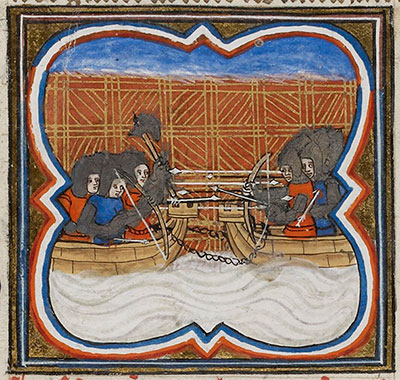
against the Saracens in Tortosa (c. 810)
Illustration of the Grandes Chroniques de France (1375-1400)
Bibliothèque nationale de France
Bishop Berenguer de Prats (1316-1340) was the driving force behind the Gothic cathedral, work that began in 1346, affecting both the old Romanesque cathedral that occupied the site where the new one was to be built, and the other auxiliary buildings of the bishopric and canonry itself. At the same time, the chapter of canons was also reorganised, fixing their number (initially nine, and later increased to twenty) and instituting the benefits of the different chaplaincies. Construction was very slow, and the section formed by the presbytery and the ambulatory surrounding it was finished in 1440, almost a century after work began. The outbuildings surrounding the cloister, the chapter house and the other canonical outbuildings located there were also rebuilt in the Gothic period.
The construction of this church was to continue for some time, and, in the 16th century, two more sections of the nave were built following the previous model. In 1593 the work was consecrated, but it was not finished until the 18th century, with the last sections of the naves, the Baroque façade and the Cinta chapel, also from this period. This canonry maintained considerable vitality, and during the 16th century the community rules were relaxed, and the canons were no longer obliged to live a strict community life; in 1529 they were freed from the obligation to sleep in community. At the time of the general secularisation of the Augustinian canons, the canons of Tortosa requested their secularisation in 1599 and on other occasions, but they did not obtain it definitively until 1772. Despite this, until the end of the 18th century they kept the old practices of novitiate and monastic profession and had St. Augustine as their patron saint.
Cloister of the Cathedral of Tortosa
The cloister of Tortosa dates back to the 13th century, when it replaced the previous one, which likely come from the Romanesque cathedral. The cloister also served as a burial space, where bishops and canons were interred, as well as citizens who could afford this distinction. It still preserves a large collection of gravestones embedded in the walls.
Altarpiece of Our Lady of the Angels
A work by Pere Serra, created for the Cathedral of Tortosa at the request of the notary Bernat Macip. It was later transferred to the Monastery of Santa Clara in the same city and eventually to the National Art Museum of Catalonia in Barcelona, where the central panel and two compartments of the predella are preserved.
- ALMUNI I BALADA, Victòria (2007). La catedral de Tortosa als segles del gòtic. Barcelona: Fundació Noguera
- ALMUNI I BALADA, Victòria i altres (2002). L’art gòtic a Catalunya. Arquitectura I. Barcelona: Enciclopèdia Catalana
- ALMUNI I BALADA, Victòria i altres (2003). L’art gòtic a Catalunya. Arquitectura II. Barcelona: Enciclopèdia Catalana
- ALMUNI I BALADA, Victòria; LLUIS I GUINOVART, Josep (2000). Sancta Maria Dertosae. La catedral de Tortosa. Tortosa: Capítol de la Catedral de Tortosa
- BAYERRI, Enrique (1957). Historia de Tortosa y su comarca. Vol. VII. Tortosa: Algueró i Baiges
- GAVÍN, Josep M. (1977). Inventari d'esglésies. Vol. 1. Montsià, Baix Ebre, Terra Alta, Ribera d’Ebre, Priorat, Matarranya. Barcelona: Arxiu Gavín
- O'CALLAGHAN, Ramon (1893). Episcopologio de la Santa Iglesia de Tortosa. Tortosa: G. Llasat
- RIPOLLÉS AMELA, Antonio (1999). Tortosa monumental. Tortosa
- ROLLAN, Xavier (1997). Santa Maria de Tortosa. Catalunya romànica. Vol. XXVI. Tortosa, Terres de l'Ebre... Barcelona: Enciclopèdia Catalana
- VIDAL FRANQUET, Jacobo (2008). Les obres de la ciutat. L’activitat constructiva de la universitat de Tortosa a la baixa edat mitjana. Barcelona: P. Abadia de Montserrat
- VILLANUEVA, Joaquín Lorenzo (1806). Viage literario a las iglesias de España. Vol. V. (Tortosa) Madrid: Imprenta Real



